Inbound Marketing: CLOSE - CRM
- Home
- Inbound Marketing: CLOSE - CRM
1. Introduction
In the ever-evolving world of digital marketing, inbound marketing has emerged as a highly effective methodology for attracting, engaging, and delighting customers. The inbound marketing methodology consists of four key stages: Attract, Convert, Close, and Delight. Each stage plays a crucial role in guiding potential customers through the buyer's journey and ultimately turning them into loyal advocates for your brand.
While attracting visitors to your website and converting them into leads are essential steps, the true success of your inbound marketing efforts lies in the Close phase. This critical stage focuses on transforming those hard-earned leads into paying customers, thus driving revenue growth for your business. It is during the Close phase that your marketing and sales teams must work together seamlessly to nurture leads, build trust, and guide them towards making a purchase decision.

However, closing deals is not without its challenges. Marketers and salespeople often face obstacles such as longer sales cycles, increased competition, and more informed buyers who demand personalized experiences. In fact, according to recent studies, 35% of salespeople say closing deals is getting harder, and 79% of marketing leads never convert to sales. These statistics highlight the importance of mastering the Close phase and implementing effective strategies to overcome these challenges.
In this blog post, we will dive deep into the Close phase of inbound marketing, exploring the key components, best practices, and tools that can help you turn more leads into customers. By understanding the intricacies of the Close phase and implementing the strategies discussed, you can optimize your lead flow, improve conversion rates, and ultimately drive sustainable business growth.
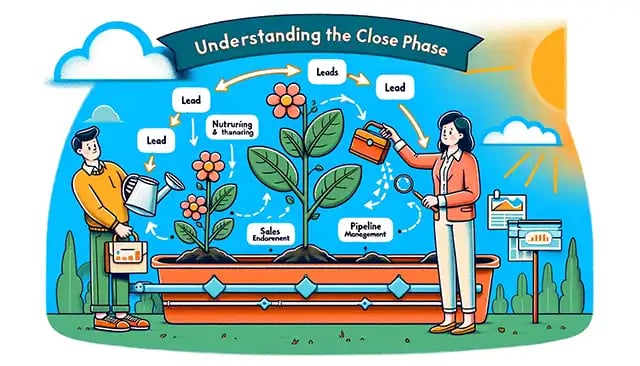
2. Understanding the Close Phase
The Close phase of inbound marketing is the stage where leads are transformed into customers. It is a critical juncture in the buyer's journey, as it represents the culmination of all the efforts put into attracting and engaging potential customers. The primary objective of the Close phase is to convert qualified leads into paying customers by providing them with the right information, support, and incentives at the right time.
To achieve this objective, the Close phase encompasses three key components: lead nurturing, sales enablement, and pipeline management.
Lead Nurturing
Lead nurturing is the process of building relationships with leads who are not yet ready to make a purchase. It involves providing valuable content, personalized communication, and timely follow-ups to keep leads engaged and moving through the sales funnel. By nurturing leads, you can build trust, establish thought leadership, and position your brand as the best solution to their needs. Effective lead nurturing requires a deep understanding of your target audience, their pain points, and their buying behaviours.
Sales Enablement
Sales enablement refers to the process of equipping your sales team with the tools, resources, and training they need to effectively engage with leads and close deals. This includes providing them with relevant content, such as case studies, product demos, and ROI calculators, to help them address the specific needs and concerns of each lead. Sales enablement also involves ensuring that your sales team is aligned with your marketing team so that they can leverage the insights and data collected throughout the buyer's journey.
Pipeline Management
Pipeline management is the process of tracking and managing the progress of leads through the sales funnel. It involves defining clear stages in the sales process, setting goals and metrics for each stage, and monitoring the performance of your sales team. Effective pipeline management requires a robust CRM system that can help you track lead behaviour, measure conversion rates, and identify bottlenecks in the sales process. By managing your pipeline effectively, you can optimize your sales efforts, prioritize high-value leads, and forecast revenue more accurately.
By focusing on these three key components of the Close phase, you can create a seamless and effective process for converting leads into customers. In the following sections, we will explore each of these components in more detail and provide actionable strategies for mastering the Close phase of inbound marketing.
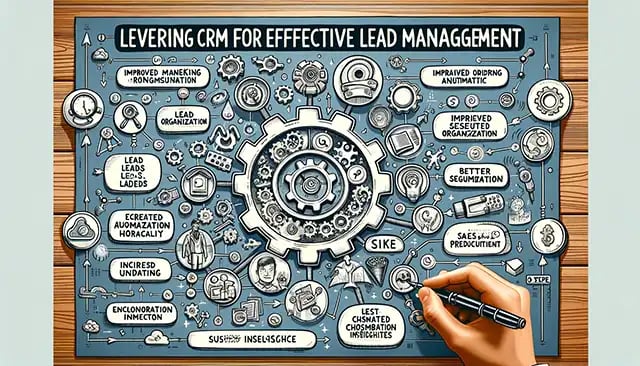
3. Leveraging CRM for Effective Lead Management
In the Close phase of inbound marketing, having a robust Customer Relationship Management (CRM) system is essential for effectively managing and nurturing leads. A CRM system serves as a centralized database that stores all the information about your leads and customers, enabling you to track their interactions with your brand, analyze their behaviour, and personalize your communication.
Benefits of using a CRM system in the Close phase:
- Improved lead organization and tracking
- Better lead segmentation and targeting
- Increased sales productivity and efficiency
- Enhanced customer insights and analytics
- Seamless collaboration between marketing and sales teams
Key features of a CRM for lead management:
Lead Segmentation and Scoring
A CRM system allows you to segment your leads based on various criteria, such as demographics, behaviour, and engagement level. This enables you to create targeted campaigns and personalize your messaging to each segment. Additionally, lead scoring helps you prioritize leads based on their likelihood to convert, so you can focus your efforts on the most promising opportunities.
Automated Lead Assignment
With a CRM system, you can automate the process of assigning leads to the right sales representatives based on predefined rules and criteria. This ensures that each lead is followed up on promptly and by the most appropriate person, reducing response times and increasing the chances of conversion.
Personalized Email Campaigns
A CRM system enables you to create and send personalized email campaigns to your leads based on their specific interests, behaviour, and stage in the buyer's journey. By leveraging the data stored in your CRM, you can create highly relevant and engaging email content that resonates with your leads and drives them closer to making a purchase decision.
Integrating CRM with your inbound marketing strategy:
To truly leverage the power of a CRM system in the Close phase, it is essential to integrate it with your overall inbound marketing strategy. This involves ensuring that your CRM system is synced with your website, marketing automation platform, and other tools so that all the data about your leads is captured and stored in a central location. By integrating your CRM with your inbound marketing strategy, you can create a seamless and cohesive experience for your leads, from the moment they first engage with your brand to the point of conversion and beyond.
Recommended CRM: HubSpot
While many CRM systems are available in the market, one of the most popular and effective options for inbound marketing is HubSpot. HubSpot offers a comprehensive suite of tools for lead management, including lead segmentation, lead scoring, automated lead assignment, and personalized email campaigns. Additionally, HubSpot's CRM system is seamlessly integrated with its marketing automation platform, making it easy to track and nurture leads throughout the entire buyer's journey.
Some of the key capabilities of HubSpot's CRM system include:
- Contact management and tracking
- Deal pipeline management
- Task and activity tracking
- Email integration and tracking
- Reporting and analytics
By leveraging a powerful CRM system like HubSpot in the Close phase of inbound marketing, you can effectively manage and nurture your leads, increase your conversion rates, and ultimately drive more revenue for your business.
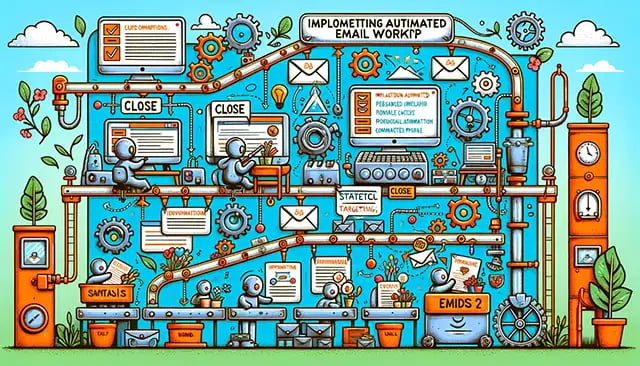
4. Implementing Automated Email Workflows
Email communication plays a crucial role in the Close phase of inbound marketing. It allows you to stay in touch with your leads, provide them with valuable information, and guide them towards making a purchase decision. However, with the increasing volume of leads and the need for personalized communication, manually sending emails to each lead can be time-consuming and ineffective. This is where automated email workflows come into play.
Importance of email in the Close phase:
Email is one of the most effective channels for nurturing leads and driving conversions in the Close phase. It allows you to deliver targeted messages directly to your leads' inboxes, build relationships with them, and keep your brand top-of-mind. According to recent studies, email marketing has an average ROI of $42 for every $1 spent, making it one of the most cost-effective ways to engage with your leads and drive sales.
Crafting effective sales emails:
To make the most of email in the Close phase, it is essential to craft effective sales emails that resonate with your leads and encourage them to take action. Some key elements of effective sales emails include:
- Compelling subject lines that grab attention
- Personalized greetings and content that speaks directly to the lead's needs and interests
- Clear and concise messaging that highlights the value of your product or service
- Strong calls to action that encourage the lead to take the next step
- Visually appealing design and layout that is easy to read and navigate
Setting up automated email workflows based on lead behaviour and attributes:
Automated email workflows allow you to send the right message to the right lead at the right time, based on their behavior and attributes. By using a marketing automation platform like HubSpot, you can create workflows that trigger emails based on specific actions or criteria, such as:
- Lead score reaching a certain threshold
- Lead visiting a specific page on your website
- Lead downloading a particular piece of content
- Lead engaging with a previous email campaign
These workflows can be customized to fit your specific business needs and goals and can be refined over time based on performance data and analytics.
Personalizing emails for higher engagement and conversion rates:
Personalization is key to creating effective email campaigns in the Close phase. By using the data stored in your CRM system, you can personalize your emails to each lead based on their specific interests, behaviour, and stage in the buyer's journey. Some ways to personalize your emails include:
- Using the lead's name in the subject line and greeting
- Referencing their previous interactions with your brand
- Providing content and offers that are relevant to their specific needs and interests
- Using dynamic content blocks that change based on the lead's attributes or behaviour
Personalized emails have been shown to have higher open rates, click-through rates, and conversion rates than generic emails, making them a powerful tool for nurturing leads and driving sales.
Best practices for email automation in the Close phase:
- Segment your leads based on their behaviour, attributes, and stage in the buyer's journey
- Create targeted email campaigns for each segment, with personalized content and offers
- Use A/B testing to optimize your subject lines, content, and calls to action
- Monitor your email performance metrics, such as open rates, click-through rates, and conversion rates, and use this data to refine your campaigns over time
- Ensure that your emails are mobile-friendly and optimized for deliverability
- Comply with email marketing regulations, such as GDPR and CAN-SPAM, to avoid legal issues and maintain the trust of your leads
By implementing automated email workflows and following best practices for email marketing in the Close phase, you can effectively nurture your leads, build relationships with them, and guide them towards making a purchase decision.
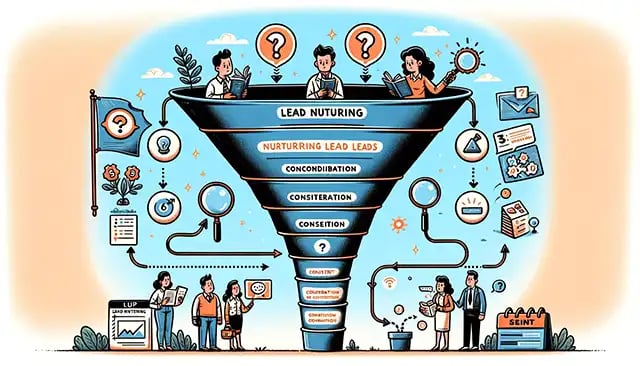
5. Nurturing Leads through the Sales Funnel
Lead nurturing is the process of guiding leads through the sales funnel by providing them with relevant and valuable content at each stage of their buyer's journey. By nurturing your leads effectively, you can build trust, establish your brand as a thought leader, and ultimately increase your conversion rates.
Understanding the buyer's journey and aligning content accordingly:
The buyer's journey is the process that a lead goes through before making a purchase decision. It typically consists of three stages: Awareness, Consideration, and Decision. To effectively nurture your leads, it is essential to understand their needs, challenges, and goals at each stage of the journey and align your content accordingly.
- Awareness Stage: In this stage, the lead is just becoming aware of their problem or need. Your content should educate them about the problem and the potential solutions available.
- Consideration Stage: In this stage, the lead is actively researching and evaluating different solutions to their problem. Your content should focus on highlighting the benefits of your product or service and how it compares to other solutions in the market.
- Decision Stage: In this stage, the lead is ready to make a purchase decision. Your content should focus on addressing any final objections, providing social proof, and making a strong case for why your product or service is the best choice.
Creating targeted content for each stage of the funnel:
To effectively nurture your leads through the sales funnel, you need to create targeted content that speaks directly to their needs and interests at each stage of the journey. Some examples of targeted content include:
- Awareness Stage: Blog posts, whitepapers, eBooks, and infographics that educate leads about the problem and potential solutions.
- Consideration Stage: Case studies, product comparisons, webinars, and demos that showcase the benefits of your product or service.
- Decision Stage: Testimonials, ROI calculators, free trials, and limited-time offers that encourage leads to make a purchase decision.
Providing value and building trust with leads:
To nurture your leads effectively, you need to focus on providing value and building trust at every stage of the journey. This means creating content that is informative, relevant, and engaging, and that addresses the specific needs and challenges of your leads. Some ways to provide value and build trust include:
- Sharing your expertise and insights through thought leadership content
- Providing practical tips and advice that helps leads solve their problems
- Offering free resources and tools that make leads' lives easier
- Being transparent and honest about your product or service, including its limitations and drawbacks
- Responding promptly to leads' questions and concerns, and providing excellent customer service
Monitoring lead engagement and adjusting nurturing strategies:
To ensure that your lead nurturing efforts are effective, you need to continuously monitor lead engagement and adjust your strategies accordingly. This means tracking metrics such as email open rates, click-through rates, website visits, and conversion rates, and using this data to refine your content and messaging over time.
Some ways to monitor lead engagement and adjust your nurturing strategies include:
- Using marketing automation tools to track lead behaviour and engagement
- Conducting A/B tests to optimize your content and messaging
- Segmenting your leads based on their behavior and preferences, and tailoring your nurturing campaigns accordingly
- Regularly reviewing your lead nurturing metrics and making data-driven decisions to improve performance
- Seeking feedback from leads and customers, and using this feedback to inform your nurturing strategies
By understanding the buyer's journey, creating targeted content, providing value and building trust, and monitoring lead engagement, you can effectively nurture your leads through the sales funnel and increase your chances of converting them into customers.
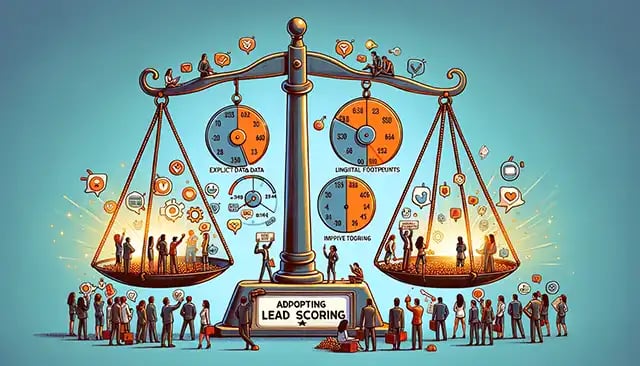
6. Adopting Lead Scoring Techniques
Lead scoring is a powerful technique that helps sales and marketing teams prioritize their efforts and focus on the leads that are most likely to convert into customers. By assigning scores to leads based on their behaviour, attributes, and engagement level, you can identify the hottest prospects and allocate your resources accordingly.
Importance of lead scoring in prioritizing sales efforts:
Not all leads are created equal. Some leads may be more interested, qualified, and ready to buy than others. By using lead scoring, you can differentiate between high-quality and low-quality leads, and prioritize your sales efforts accordingly. This allows you to:
- Focus your time and resources on the leads that are most likely to convert
- Provide a more personalized and targeted sales approach to high-quality leads
- Reduce the time and effort wasted on low-quality or unqualified leads
- Improve your overall conversion rates and revenue
Defining explicit and implicit lead data:
To implement a lead scoring system, you need to collect and analyze both explicit and implicit lead data.
Explicit data is information that is directly provided by the lead, such as their job title, company size, budget, and timeline. This data is typically collected through web forms, surveys, or conversations with sales representatives.
Implicit data is information that is inferred based on the lead's behaviour and engagement with your brand. This includes actions such as opening emails, visiting specific web pages, downloading content, and attending webinars. Implicit data provides valuable insights into the lead's interests, preferences, and intent.
Implementing a lead scoring system:
To implement a lead scoring system, you need to follow these steps:
- Define your ideal customer profile and the attributes that make a lead-qualified
- Assign point values to each attribute and behaviour based on their importance and relevance
- Set up a scoring model in your marketing automation or CRM system
- Track and analyze lead behaviour and engagement data
- Use lead scores to prioritize and segment your leads
- Refine your scoring model over time based on feedback and results
Leveraging predictive lead scoring for advanced targeting:
Predictive lead scoring takes traditional lead scoring to the next level by using machine learning algorithms to analyze large amounts of data and identify patterns and trends that predict a lead's likelihood to convert. By leveraging predictive lead scoring, you can:
- Identify high-quality leads that may have been missed by traditional scoring methods
- Provide more accurate and personalized recommendations to sales representatives
- Optimize your marketing campaigns and content based on predictive insights
- Improve your overall conversion rates and revenue
Aligning sales and marketing teams through lead scoring:
Lead scoring is not just a tool for sales teams, but also a way to align sales and marketing efforts and improve collaboration between the two teams. By using a common language and framework for evaluating leads, sales and marketing can:
- Agree on the definition of a qualified lead and the criteria for lead handoff
- Provide feedback and insights to each other based on lead behaviour and performance
- Optimize their respective strategies and tactics based on shared goals and metrics
- Improve the overall customer experience and journey
By adopting lead-scoring techniques and aligning sales and marketing teams, you can effectively prioritize your efforts, target the right leads, and increase your conversion rates in the Close phase of inbound marketing.
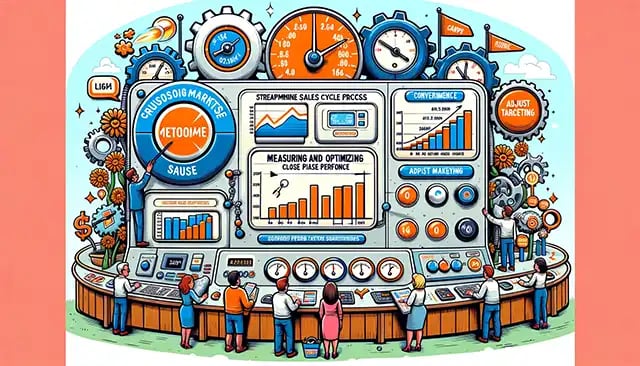
7. Measuring and Optimizing Close Phase Performance
Measuring and optimizing the performance of your Close-phase strategies is essential for driving continuous improvement and maximizing your results. By tracking key metrics, analyzing data, and refining your approaches, you can identify areas for improvement and make data-driven decisions to optimize your sales and marketing efforts.
Key metrics to track in the Close phase:
- Conversion Rates
- Sales Cycle Length
- Revenue Generated
Conversion rates measure the percentage of leads that successfully convert into customers. This metric is critical because it directly reflects the effectiveness of your Close-phase strategies. By tracking conversion rates at different stages of the funnel, such as MQL to SQL and SQL to Customer, you can identify bottlenecks and opportunities for improvement.
Sales cycle length measures the average time it takes for a lead to move through the entire sales funnel, from initial contact to closing the deal. By tracking this metric, you can identify ways to streamline your sales process, remove bottlenecks, and accelerate your sales cycle.
Revenue generated measures the total amount of revenue that your Close-phase strategies are producing. This metric is essential for evaluating the overall ROI of your sales and marketing efforts and for setting realistic goals and budgets.
Other important metrics to track in the Close phase include:
- Lead-to-customer rate
- Average deal size
- Win/loss ratio
- Customer acquisition cost (CAC)
Analyzing data to identify areas for improvement:
To optimize your Close phase performance, you need to regularly analyze the data you collect and look for patterns, trends, and insights that can inform your strategies. Some ways to analyze your Close-phase data include:
- Segmenting your data by lead source, campaign, or other relevant criteria to identify high-performing and low-performing segments
- Conducting cohort analysis to understand how different groups of leads behave over time
- Using data visualization tools to identify patterns and outliers in your data
- Conducting A/B tests to evaluate the effectiveness of different Close-phase tactics and messages
- Gathering feedback from sales representatives and customers to identify areas for improvement
Continuously refining your Close phase strategies:
Optimizing your Close-phase performance is an ongoing process that requires continuous refinement and adaptation. As you gather more data and insights, you should regularly review and adjust your strategies to ensure that they are aligned with your goals and deliver the best possible results. Some ways to continuously refine your Close-phase strategies include:
- Setting clear and measurable goals for your Close-phase performance, and tracking progress against those goals
- Regularly review your Close-phase metrics and data to identify trends and areas for improvement
- Experimenting with new Close phase tactics and technologies, and measuring their impact on performance
- Collaborating with sales and marketing teams to share insights and best practices, and to ensure alignment around shared goals
- Staying up-to-date with industry trends and best practices, and adapting your strategies accordingly
By measuring and optimizing your Close phase performance, you can drive continuous improvement in your sales and marketing efforts, and ultimately achieve better results for your business. By tracking key metrics, analyzing data, and refining your strategies, you can identify areas for improvement, make data-driven decisions, and adapt to changing market conditions and customer needs.
8. Conclusion
In this blog post, we have explored the critical role of the Close phase in the inbound marketing methodology and discussed the key strategies and tactics for turning leads into customers. We have covered the importance of lead management, nurturing, and scoring, and highlighted the benefits of using a CRM system like HubSpot to streamline and optimize your Close phase efforts.
Mastering the Close phase is essential for driving business growth and achieving long-term success with inbound marketing. By effectively nurturing and converting leads, you can generate more revenue, build stronger relationships with your customers, and create a sustainable competitive advantage in your market.
To recap, some of the key points we have covered include:
- The importance of lead nurturing and providing value to leads throughout the buyer's journey
- The benefits of using a CRM system for lead management, segmentation, and personalization
- The role of automated email workflows in delivering timely and relevant content to leads
- The importance of lead scoring in prioritizing sales efforts and aligning marketing and sales teams
- The need for continuous measurement, analysis, and optimization of Close phase performance
By implementing the strategies and tactics discussed in this post, you can take your Close phase efforts to the next level and drive better results for your business. Whether you are just getting started with inbound marketing or looking to optimize your existing efforts, these proven approaches can help you attract, convert, and retain more customers over time.
If you are looking for expert guidance and support in mastering the Close phase and driving growth with inbound marketing, the team at Whitehat is here to help. As a leading inbound marketing agency, we have the knowledge, skills, and experience to help you design, implement, and optimize your Close phase strategies and tactics.
From CRM implementation and integration to lead nurturing and scoring, our team can provide the end-to-end support you need to succeed with inbound marketing. We can work with you to develop a customized phase strategy that aligns with your unique business goals, target audience, and competitive landscape, and help you measure and optimize your performance over time.
So if you are ready to take your inbound marketing efforts to the next level and drive more leads, customers, and revenue for your business, we encourage you to reach out to the team at Whitehat today. With our proven track record of success and deep expertise in inbound marketing, we can help you master the Close phase and achieve your growth objectives.
Contact us today to learn more about our services and how we can help you succeed with inbound marketing.
Other blogs you might like...
- Inbound Marketing: CONVERT - Contacts
- Inbound Marketing: CONVERT - Landing Pages
- Inbound Marketing: CONVERT - Calls To Action
- Inbound Marketing: CONVERT - Forms

